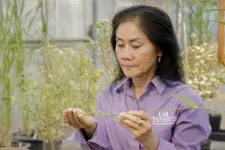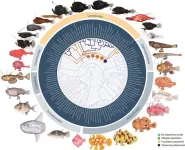(Press-News.org) A team led by researchers at UCLA and the University of Pennsylvania has produced a first-of-its kind catalog of gene-isoform variation in the developing human brain. This novel dataset provides crucial insights into the molecular basis of neurodevelopmental and psychiatric brain disorders and paves the way for targeted therapies.
The research, published in Science, also details how transcript expression varies by cell type and maturity, finding that changing gene-isoform expression levels can help us better understand how the human brain develops.
Every cell in our body contains the same genetic information encoded in DNA, but it is the expression of different proteins, encoded in mRNA transcripts, that give cells their distinct functions. These varied proteins, or isoforms, mostly arise from alternative splicing — a process that is highly prevalent in the brain and contributes to its wide range of proteins and characteristics.
“We knew, based on our previous research, that isoform regulation is a key molecular feature for understanding brain development and genetic risk for neuropsychiatric disorders,” said Dr. Luis de la Torre-Ubieta of the Eli and Edythe Broad Center of Regenerative Medicine and Stem Cell Research at UCLA, who co-led the study alongside Dr. Michael Gandal, an associate professor of psychiatry and genetics in the Perelman School of Medicine at the University of Pennsylvania.
Previously, despite its prevalence, the role of cell-type-specific splicing and transcript-isoform diversity in the developing human brain had not been systematically investigated due to limitations in prior generations of sequencing technologies. Here, the researchers were able to leverage new third-generation long-read sequencing technologies to capture complete RNA molecules and profile the full-length transcriptome of two major regions of the developing neocortex: the germinal zone, which contains stem cells, and the cortical plate, which houses newly generated neurons.
This technology allowed the researchers to uncover 214,516 unique isoforms — over 70% of which have never been previously studied. They then compared the two regions of the developing brain and observed that changes in isoform expression levels are important for neurogenesis, differentiation and cell fate — in essence, the maturation of the brain.
The researchers found thousands of isoform switches that occur during brain development, implicating previously uncharacterized RNA-binding proteins in cellular identity and cellular fate decisions. Their findings also elucidate genetic risk mechanisms for neurodevelopmental and neuropsychiatric disorders, including a reassessment of the significance and clinical relevance of thousands of rare genetic variants.
“We found that high-confidence risk genes for autism or neurodevelopmental disorders tend to be genes that have more isoforms, and those isoforms are expressed differently during neurogenesis,” said de la Torre-Ubieta, an assistant professor of psychiatry and behavioral sciences. “This implies that dysregulation of the expression of specific isoforms is a potential mechanism underlying these disorders.”
Scientists studying the brain often rely on publicly available catalogs of genes and gene transcripts. However, human brain tissue, particularly embryonic tissue, is difficult to access, restricting the comprehensiveness of these datasets. For this study, the researchers obtained six developing human neocortex tissue samples representing the mid-gestation period, or 15 to 17 weeks post-conception. This developmental time point in the human brain is a critical window during which the complexity of our brain — the most sophisticated organ in our body — begins to emerge.
“These tissue samples enabled a striking level of novel transcript discovery,” Gandal said. “And because these databases haven’t incorporated or represented these critical time points, we can dramatically expand our understanding of how genes are regulated in the context of human brain development.”
The findings from the study have strong therapeutic implications and could be clinically actionable, the researchers said. Uncovering new transcripts could pave the way for identifying novel treatment approaches in gene therapy trials or targeted therapeutic trials for individuals harboring rare mutations associated with psychiatric or neurodevelopmental disorders.
In the nearer term, the data also has direct implications in improving our ability to make genetic diagnoses of neurodevelopmental disorders. Because the study found several thousand genetic variants that are more impactful than previously thought, families or individuals carrying those variants can better understand how their children might be predisposed to certain disorders.
Gandal has shared the dataset with several colleagues at the Children’s Hospital of Philadelphia, which has a large population of children with rare neurodevelopmental disorders or undiagnosed disorders in development. Physicians there are already using this resource to help better interpret neurogenetics diagnostically.
“I’m really excited to leverage this resource to help patients,” said Gandal, who is also a practicing psychiatrist. “Having this knowledge brings us one step closer to being able to develop targeted treatments and understand genetic mechanisms in a much more specific way.”
Other UCLA authors include Ashok Patowary, Pan Zhang, Celine K. Vuong, Xinzhou Ge, Kangcheng Hou, Minsoo Kim, Michael Margolis, Bogdan Pasaniuc and Jingyi Jessica Li. Connor Jops, Naihua Gong, Daniel Vo, Xusheng Wang and Chunyu Liu contributed to this study.
The research was supported by the Simons Foundation Autism Research Initiative, the National Institute of Mental Health, the National Science Foundation and the UCLA Medical Scientist Training Program.
END
Sequencing of the developing human brain uncovers hundreds of thousands of new gene transcripts
New study could improve the ability to make genetic diagnoses and treat neurodevelopmental disorders
2024-05-23
ELSE PRESS RELEASES FROM THIS DATE:
Carnegie Mellon University researchers to tackle carbon use, sustainability through NSF expeditions in computing awards
2024-05-23
Researchers from Carnegie Mellon University's School of Computer Science will contribute to two multi-institution research initiatives aimed at reducing the use of carbon and creating sustainable computing.
The projects recently received funding through the U.S. National Science Foundation's (NSF) Expeditions in Computing Awards program, which is providing $36 million to three projects selected for their potential to revolutionize computing and make significant impacts toward reducing the carbon footprint of the lifecycle of computers. The ...
USDA-NIFA grant supports microwave tech to zap weed seeds
2024-05-23
By John Lovett
University of Arkansas System Division of Agriculture
FAYETTEVILLE, Ark. — It’s not just for burritos and popcorn. Microwave technology is also being tested as a new tool to destroy weed seeds and decrease herbicide use.
Scientists and engineers with the Arkansas Agricultural Experiment Station are investigating the use of 915 MHz microwaves to neutralize a variety of weed seeds underground. The study is supported by a nearly $300,000 Agriculture and Food Research Initiative grant from the U.S. Department of Agriculture’s National Institute of Food and Agriculture, with additional support ...
Research spotlight: AI enabled body composition analysis predicts outcomes for patients with lung cancer treated with immunotherapy
2024-05-23
Tafadzwa Chaunzwa, MD, a researcher in the Artificial Intelligence in Medicine (AIM) Program at Mass General Brigham and a senior resident physician at the Harvard Radiation Oncology Program, is the lead author of a paper published in JAMA Oncology. Chaunzwa and senior author Hugo Aerts, PhD, director of the AIM Program, and associate professor at Harvard University, shared highlights from their paper.
How would you summarize your study for a lay audience?
As treatments like immunotherapy improve cancer survival rates, there is a growing need for clinical decision-support tools that predict treatment response ...
Silky shark makes record breaking migration
2024-05-23
In a recent study, researchers from the Charles Darwin Foundation (CDF), in collaboration with the Guy Harvey Research Institute (GHRI) and Save Our Seas Foundation Shark Research Center (SOSF-SRC) at Nova Southeastern University in Florida, and the Galapagos National Park Directorate (GNPD) have documented the most extensive migration ever recorded for a silky shark (Carcharhinus falciformis), revealing critical insights into the behavior of this severely overfished species and emphasizing the urgent need for cooperative international management measures to prevent further population declines.
The ...
Sexual parasitism helped anglerfish invade the deep sea during a time of global warming
2024-05-23
Members of the vertebrate group including anglerfishes are unique in possessing a characteristic known as sexual parasitism, in which males temporarily attach or permanently fuse with females to mate. Now, researchers reporting in the journal Current Biology on May 23 show that sexual parasitism arose during a time of major global warming and rapid transition for anglerfishes from the ocean floor to the deep, open sea.
The findings have implications for understanding evolution and the effects that global warming may have in the deep sea, according to the researchers.
“Our results show how the ...
Archaeology: Differences in Neanderthal and Palaeolithic human childhood stress
2024-05-23
Neanderthal children (who lived between 400,000 and 40,000 years ago) and modern human children living during the Upper Palaeolithic era (between 50,000 and 12,000 years ago) may have faced similar levels of childhood stress but at different developmental stages, according to a study published in Scientific Reports. The authors suggest that these findings could reflect differences in childcare and other behavioural strategies between the two species.
Laura Limmer, Sireen El Zaatari and colleagues analysed the dental enamel of 423 Neanderthal teeth (from 74 Homo neanderthalensis individuals) and 444 Upper Palaeolithic humans (from 102 Homo sapiens ...
Rising temperatures will significantly reduce streamflow in the upper Colorado river basin as groundwater levels fall, new research shows
2024-05-23
The Colorado River makes life possible in many Western cities and supports agriculture that sustains people throughout the country. Most of the river’s water begins as snowmelt from the mountainous watersheds of Colorado, Utah, and Wyoming, and a warming climate will drastically reduce these streamflows, new research finds.
Researchers from Desert Research Institute (DRI), USGS, and Lawrence Berkeley National Laboratory teamed up for the new study, published May 23 in Nature Water. By applying warming to historical conditions for the East River in Colorado and using computer simulations to observe the impact on streamflow and groundwater ...
Prenatal exposure to chemical mixtures and metabolic syndrome risk in children
2024-05-23
About The Study: The findings of this cohort study suggest that prenatal exposure to endocrine-disrupting chemical mixtures may be associated with adverse metabolic health in children. Given the pervasive nature of endocrine-disrupting chemicals and the increase in metabolic syndrome, these findings hold substantial public health implications.
Corresponding Author: To contact the corresponding author, Martine Vrijheid, Ph.D., email martine.vrijheid@isglobal.org.
To access the embargoed study: Visit our For The Media ...
Effectiveness of a school- and primary care–based HPV vaccination intervention
2024-05-23
About The Study: In this cluster randomized trial, within the context of the late COVID-19 pandemic period and limited school and general practitioner participation, at-school human papillomavirus (HPV) vaccination significantly increased vaccination coverage. The trial did not show a significant effect for training general practitioners and education and motivation, although it may be observed after more time has elapsed after the intervention.
Corresponding Author: To contact the corresponding author, Morgane Michel, Ph.D., email morgane.michel@aphp.fr.
To access the embargoed study: Visit our For The Media website at this link https://media.jamanetwork.com/
(doi:10.1001/jamanetworkopen.2024.11938)
Editor’s ...
Exposure to mixtures of endocrine-disrupting chemicals during pregnancy is associated with higher odds of metabolic syndrome in children
2024-05-23
The term ‘metabolic syndrome’ (MetS) encompasses a group of factors, such as abdominal obesity, hypertension and insulin resistance, that together increase the risk of cardiovascular disease and type 2 diabetes. A new study suggests that prenatal exposure to a combination of endocrine disrupting chemicals (EDCs) is associated with a poorer metabolic health in childhood, which in turn may contribute to an increased risk of metabolic syndrome in adulthood. The research, led by the Barcelona Institute for Global Health (ISGlobal), a centre supported by the "la Caixa" Foundation, has been published in JAMA Network Open.
EDCs ...
LAST 30 PRESS RELEASES:
Fat tissue around the heart may contribute to greater heart injury after a heart attack
Jeonbuk National University researcher proposes a proposing a two-stage decision-making framework of lithium governance in Latin America
Chromatin accessibility maps reveal how stem cells drive myelodysplastic progression
Cartilaginous cells regulate growth and blood vessel formation in bones
Plant hormone allows lifelong control of proteins in living animal for first time
Swedish freshwater bacteria give new insights into bacterial evolution
Global measures consistently underestimate food insecurity; one in five who suffer from hunger may go uncounted
Hidden patterns of isolation and segregation found in all American cities
FDA drug trials exclude a widening slice of Americans
Sea reptile’s tooth shows that mosasaurs could live in freshwater
Pure bred: New stem cell medium only has canine components
Largest study of its kind highlights benefits – and risks – of plant-based diets in children
Synergistic effects of single-crystal HfB2 nanorods: Simultaneous enhancement of mechanical properties and ablation resistance
Mysterious X-ray variability of the strongly magnetized neutron star NGC 7793 P13
The key to increasing patients’ advance care medical planning may be automatic patient outreach
Palaeontology: Ancient tooth suggests ocean predator could hunt in rivers
Polar bears may be adapting to survive warmer climates, says study
Canadian wildfire smoke worsened pediatric asthma in US Northeast: UVM study
New UBCO research challenges traditional teen suicide prevention models
Diversity language in US medical research agency grants declined 25% since 2024
Concern over growing use of AI chatbots to stave off loneliness
Biomedical authors often call a reference “recent” — even when it is decades old, analysis shows
The Lancet: New single dose oral treatment for gonorrhoea effectively combats drug-resistant infections, trial finds
Proton therapy shows survival benefit in Phase III trial for patients with head and neck cancers
Blood test reveals prognosis after cardiac arrest
UBCO study finds microdosing can temporarily improve mood, creativity
An ECOG-ACRIN imaging study solves a long-standing gap in metastatic breast cancer research and care: accurately measuring treatment response in patients with bone metastases
Cleveland Clinic presents final results of phase 1 clinical trial of preventive breast cancer vaccine study
Nationally renowned anesthesiology physician-scientist and clinical operations leader David Mintz, MD, PhD, named Chair of the Department of Anesthesiology at the UM School of Medicine
Clean water access improves child health in Mozambique, study shows
[Press-News.org] Sequencing of the developing human brain uncovers hundreds of thousands of new gene transcriptsNew study could improve the ability to make genetic diagnoses and treat neurodevelopmental disorders




